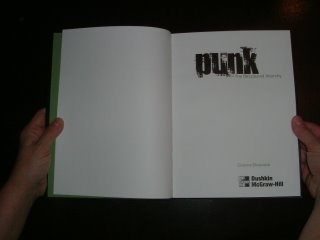 Full Title. Punk. Structured Anarchy
Full Title. Punk. Structured Anarchy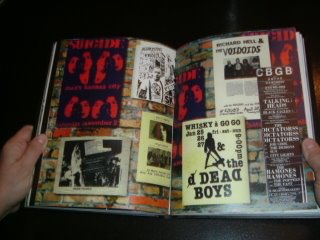 Spread One: Brick wall with original posters from the punk scene
Spread One: Brick wall with original posters from the punk scene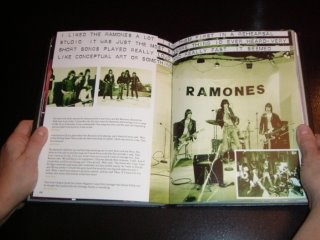 Spread Two: One column grid with a running pull quote. Full bleed.
Spread Two: One column grid with a running pull quote. Full bleed.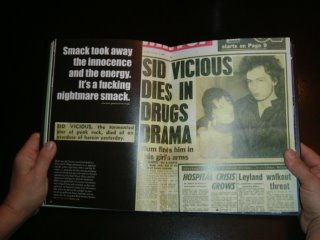 Spread Three: An original article from 1979 about Sid Vicious' death.
Spread Three: An original article from 1979 about Sid Vicious' death. Spread Four: An transcript of an interview with Debbie Harry and Chris Stein
Spread Four: An transcript of an interview with Debbie Harry and Chris Stein Spread Five: All my spreads are full with images, copy, and pull quotes. Little white space needed.
Spread Five: All my spreads are full with images, copy, and pull quotes. Little white space needed. Spread Six: Minimal content in this spread. The main focus was the pull quote which says enough.
Spread Six: Minimal content in this spread. The main focus was the pull quote which says enough.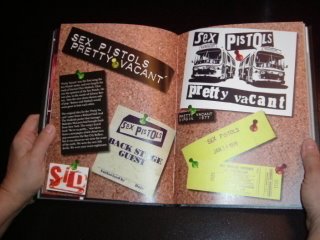 Spread Seven: The corkboard spreads come up every so often. Includes albums, tickets, backstage pass, poster, lyrics...etc.
Spread Seven: The corkboard spreads come up every so often. Includes albums, tickets, backstage pass, poster, lyrics...etc. Spread Eight: This spread only has a running pull quote and full bleed images. Minimal.
Spread Eight: This spread only has a running pull quote and full bleed images. Minimal. Spread Nine: There is a transcript on the side of this page but a conversation Sid and Nancy had.
Spread Nine: There is a transcript on the side of this page but a conversation Sid and Nancy had.1. A Character Sketch of the Book: describe your book in general terms (what it look like, how the information/story is organized) as of talking to someone who has never seen it.
I did not know much about punk music prior to designing this book. The inspiration for the design came from the sporadic nature of the music. The book is designed such that it reflects my thought process as I researched the selected subject matter. This means that the method through which I covered the various texts on the topic was used to structure the book. If I referred to a book on punk, I read segments of it that interested me the most. Those segments were then placed in conjunction with one another, resulting in a structured anarchy. The unique aspect of this book is that the different parts come in many forms including direct quotes from the band members, interviews, biographies and journal entries. Moreover, with further research, my interests in different aspects of the topic grew, and so did my desire to include the new information in my book.
Essentially, the book is set up so that it is as though I am visually describing a story about the history of punk music through the process of which I learned the material.
2. The Evolution of the Project: reflect on how the book has changed over time from its original conception.
From the very beginning of the semester, I had been doing a lot of research on a punk nightclub, CBGB. All my content, images, design concepts revolved around that topic. For some reason, I felt limited with what I could have done with it and decided to simply focus on the entirety of the punk era. With my new idea set forth, I had new ideas, which were very different from what the outcome of my book became.
I wanted the structure of my book to be in sections of the major locations, which influenced punk music. In each location, I would touch upon four to five artist and describe them in detail. Quite funny since my book took an entire turn from that initial idea. From an organized structured to a chaotic mess.
3. Making Choices: pick two important choices you have made concerning your book (type, format, layout, images, etc.) and talk about why you made those particular decisions.
One of the choices I made right at the beginning of my design was to set up the book so that it would be printed and bounded in signatures. I knew I wanted the photographs and pull quotes to be large in size and bleed onto the next page. Therefore it was essential to create it in such a way. It turned out to be a challenge in itself due to the fact that I had way too much images and copy that spread between two pages. And if you know about signature, all the pages need to match up with another page, meaning I had to slice every picture in half which took a while considering I had 132 pages.
The second most important choice I made was how to set up the content. Punk music is a huge topic on its own and I was not trying to impose that I was now an expert in the topic. I structured the content in such a way that myself and the readers can fill in the missing pieces of the puzzle. Some of the stories you could get in full while some you could not, it was all about my learning development of this new topic and how I personally interpreted it.
4. Compromises: describe some of the things (if time or money wasn’t an issue) you might have done differently and what they would have added to your book.
With an unlimited budget, I would first like to have visit New York City and London to gather more primary information about punk. I was lucky to find a lot of information but I was really hoping it would have been more personal. The pages I would have liked my book to take on were the personal stories, journal entries, and candid interview. I am just assuming that the libraries in those two locations would have a bit of what I was looking for.
Also, if I had an extra week or so, I would have liked to make a box to showcase my book in as well as a foil-stamped cover. Oh yeah, and maybe some real leather skin for the cover.
5. Pleasure and Frustrations: talking about book design in general–if you were with other students thinking about enrolling in a book design course (not necessarily this course) what would you tell them to expect and what to consider before they make their decision.
I am very glad that I chose to enroll in a book design course before I left this program. I felt like a learned a lot of skills through the process that I never knew throughout my four years of university. Although yes the workload was heavy, it was all worth it once I picked up my book from the bookbinder and saw it all together. By looking at the book you created, you can see all the struggles, challenges, decisions,.etc that needed to be made. One piece of advice I would give to anyone who wanted to enroll in a book design course is to have passion in whatever you do. If you have a strong desire for your book, then it makes it all worth it in the end.
No comments:
Post a Comment